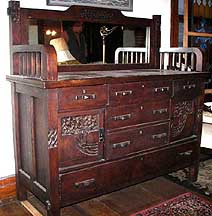Illustrated FURNITURE Glossary ..... Arts and Crafts - Architecture
Furniture - Mission Style (Arts
& Crafts)
1900-1925

|
Mission / Arts and Crafts Styles: 1900-1925 Proportions Squat and boxy. Essential elements Simple rectilinear forms. Rows of vertical or horizontal slats across chair and settee backs. Exposed tenons, sometimes secured by wooden pegs or keys. Leather upholstery. More decoration on examples in the Arts and Crafts tradition. Wood Oak. Notable forms Chair. Settee. Bench. Settle. Small and large tables.
|
The style was originally associated with furniture supposedly housed in the old Franciscan missions of California. Seen as a revival of medieval and other primarily functional designs, the Mission style was the major American expression of the Arts and Crafts style that had evolved in England.
Oak was the favored wood and forms were rectilinear and as strictly functional as possible. Simple construction with obvious signs of handwork was a hallmark of the Mission style.
The most important designs were by the furniture maker Gustav Stickley, who was also the publisher of a magazine, The Craftsman, which popularized the new style. Stickley had some fine competitors, including several of his brothers.
One designer in the Stickley company was Harvey Ellis whose designs are still being manufactured today. See examples in the Minot Tanner House.
Morris style
As far as is known, William Morris never designed any furniture but devoted his attention to other crafts, particularly printing, fabrics and book production; furniture design was the province of Philip Webb.
As regards furniture, the range of designs eventually came to comprise two categories. On the one hand there were the comparatively simple, plain and utilitarian designs as exemplified by the Sussex chair and the ladderback chair; and on the other, pieces which were ornate in the extreme, with elaborate decoration and painted panels of pre-Raphaelite subjects by Burne-Jones, Madox Brown, or Rossetti.
The painter, William Holman Hunt, also worked with the firm. In 1857 he had designed and made for himself an oak table, which he stained green: this kind of colored finish was adopted by the firm and applied to many of the simpler pieces and became a distinguishing feature.
(One important influence on Mission style (Arts & Crafts) furniture was the Aesthetic Movement of the 1890s)
Examples from Buffalo:
- Illustration above: David Kendall sideboard - 65 Elmwood Ave., Carl Slone Antique Lighting and Windows
- Charles Rohlfs in Buffalo
- Furnishings - Roycroft Inn
- Miscellany - Elbert Hubbard / Roycroft Museum
- Morris chair - Private collection, Amherst, NY
- Desk - Old Editions Book Shop and Café
- Frank Lloyd Wright designs - Graycliff
- Life-Time sofa - Private collection, Western NY
- Settle - Roycroft Print Shop
- 5 Stickley-made pieces - Private collection, Western NY
- Mission sideboard, Private collection
- Table - Connecticut Street Armory
- Bungalows - Interiors
- Reverse Painted table lamp - Blocher Homes
Other examples:
- Charles Rennie Mackintosh bedroom set - Musée d'Orsay, Paris, France
- Philip Webb buffet - Musée d'Orsay, Paris, France
- Frank Lloyd Wright furniture - Musée d'Orsay, Paris, France
- William Morris & William Frend de Morgan mural panes - Musée d'Orsay, Paris, France
- Sir Edward Burne-Jones, Wheel of Fortune - Musée d'Orsay, Paris, France
- Sir Edward Burne-Jones, Princesse Sabre, ou La Fille du rois - Musée d'Orsay, Paris, France
- See also: The Collectors Weekly: "Mission Oak Style" (2011) Illustrations with ebay links

web site consulting by ingenious, inc.